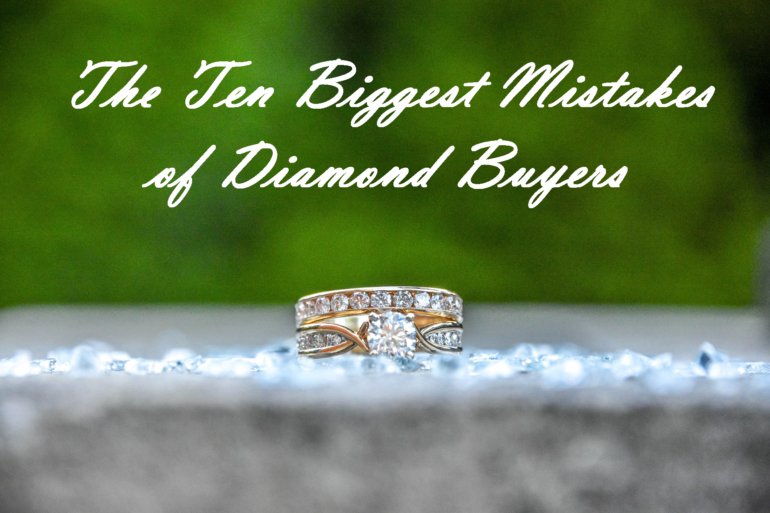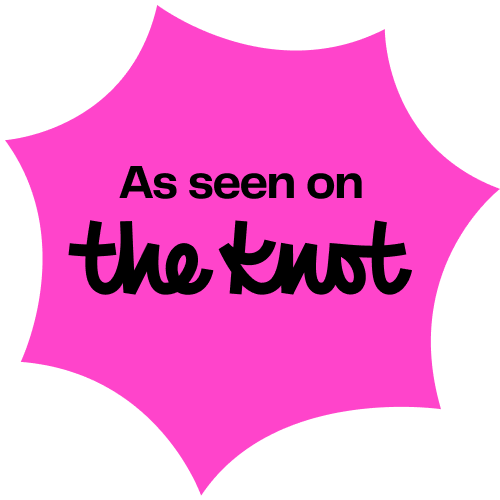
1. ASSUMING ALL DIAMONDS OF THE SAME COLOR, CLARITY, AND CUT GRADE ARE THE SAME
Although GIA has made great strides forward with their new cut grading system (for round diamonds only), the system is nevertheless one of laboratory measurements. As a result, there is a wide variation in how beautiful a diamond appears if ranked by the gemologist at the high end of any cut grade from one ranked low in the same cut grade. (For round diamonds, there is about a 30% price differential from the top to the bottom of the same cut grade). No two diamonds, even with the same numbers, handle light or “perform” the same.
2. ASSUMING EVERYTHING YOU NEED TO KNOW ABOUT A DIAMOND IS ON THE CERTIFICATE, AND THAT A DIAMOND CAN BE PURCHASED “BY THE NUMBERS” ALONE
In addition to color and clarity, many consumers like to analyze the depth and table percentages of a diamond. While these numbers can be used to eliminate certain stones as not being properly cut, not even an expert can tell if a diamond is well cut by looking only at the numbers. The reason for this is that cutters can employ an angle shifting technique that results in depth and table percentages that appear to be correct on the certificate. In other words, they can make a diamond look “paper pretty.”
Marange diamonds with their unique body tint (a characteristic NOT denoted on the GIA certificate, though detectable by a trained gemologist) add another variable to the pricing equation as these stones command lower prices in the dealer network. (M. Martin does NOT sell Marange sourced diamonds.)
Another much more serious omission from the certificate is an analysis of the diamond material. For reasons that are too technical to go into here, diamond material can vary from stone to stone. Some diamond material may be very “grainy,” while it is the “crystal” material that is most desired and most valuable. Many jewelers do not know how to distinguish this phenomenon, but an experienced gemologist who knows what to look for is able to detect this using specific gemological techniques.
3. ASSUMING EVERYONE SELLING DIAMONDS IS A GIA GRADUATE GEMOLOGIST
I find this to be the most important question consumers never ask: “Are you a GIA Graduate Gemologist?” (This is a good question to ask before making your appointment.) Unfortunately, there are no federal or state qualifications, training, or licensing required for someone to sell a diamond (hard to believe, but true). Even the jeweler who has been “selling diamonds for 30 years” may know little more than you if he has not had GIA training and certification. Ask to see their credentials. At M. Martin and Company our GIA credentials are displayed in our showroom. Anyone can sell a diamond, but would you trust buying a diamond from just “anyone?”
4. ASSUMING LABORATORY GRADING IS ALWAYS ACCURATE AND UNIFORM TO INDUSTRY STANDARDS.
Unfortunately, each laboratory sets its own policy on how “strict” or how “loose” they will grade diamonds. Many dealers and stores like to use certificates from laboratories that give diamonds inflated grades (3 to 5 grades higher is not unusual) because it increases their profit margins (at the customer’s expense, of course). Here is an example: Let’s say a cutter has a diamond that would legitimately grade as color “K” and clarity – imperfect “I1”. He submits it to a laboratory that inflates grades which then issues a certificate stating the diamond is of color-“H” and clarity SI1, which is, of course, a fictitious grade. The customer now thinks he is getting a “bargain”, but all he is purchasing is a misgraded and mislabelled diamond. For more information and to see which labs should be avoided, see our web page entitled “Critique of the Laboratories.” Remember, too, even graders at the best and strictest labs can make incorrect calls (they are human, after all). At M. Martin and Co. we regrade every certified diamond to double check the accuracy of the certificate (another reason to buy only from a GIA Graduate Gemologist).
5. ASSUMING COLOR AND CLARITY ARE THE MAJOR DETERMINANTS IN PRICING A DIAMOND
In fact, the largest variant in diamond pricing is the cutting. Each color and clarity grade sets a range of prices, and these ranges overlap. Cutting alone may cause as much as a 50% variation in price for a specific color and clarity grade. Inherent shortcomings in the diamond material may cause an additional 25% variation. Therefore, there could be as much as a 75% variation in the price of two diamonds with the same weight, color, and clarity. Gemologists also look at many other characteristics of a diamond before making a judgment as to its overall quality.
6. ASSUMING THAT CHOOSING A SPECIFIC COLOR AND CLARITY GRADE AND THEN SHOPPING FOR THE LOWEST PRICE WILL YIELD THE BEST DIAMOND
While it is good to comparison shop in order to find the best value, the lowest price diamond of any specific color and clarity grade is usually the one with the worst cut or some inherent gemological shortcomings in the diamond material. De Beers sets the price on rough diamonds, and this often translates into a fixed price at the wholesale level. Prices at the retail level may vary more depending on the jewelry store where the diamond is sold. However, the diamond that is offered at the “bargain price” is usually the one of which you would want to be most wary. If you were to look at someone’s “list” of diamonds of a certain grade, you would see a wide range of prices, from low to high. You can certainly assume the least expensive stones on the list are the weakest and worst in the category. (Unfortunately, the opposite is not true. There is no way to tell how good the most expensive stone on the list is. It may be a mediocre stone–it is just the best they carry.) If you are aware that each grade combination is always a RANGE of prices, you won’t fall prey to the dealer whose low price is only because his stone is THE MOST INFERIOR IN THAT PARTICULAR GRADE CLASS.
7. ASSUMING ALL DIAMONDS ARE WELL CUT
Again, this is unfortunately not true. Statistics show that 95% of all diamonds cut are not properly proportioned. The reason for this lies in the original shape of the rough diamond crystal. The further a diamond cutter strays from the ideal proportioning of the diamond, the more weight he is able to retain on the stone. For example, a cutter may have a rough diamond crystal which, if cut to ideal proportions, would produce a diamond weighing .85 carats. He could instead cut this same rough diamond crystal with a high crown and a deep pavilion, making it now weigh one carat. Not only would the one carat diamond still have the diameter of a .85 carat diamond, but it would also show reduced brilliance because all of the angles of the facets would be incorrect. But the cutter, and subsequently the jeweler, can now make the consumer believe that he is getting a better bargain by offering a one carat off-make diamond for the same price as a .85 carat well-proportioned diamond.
8. ASSUMING EVERY STORE GRADES DIAMONDS TO PROPER STANDARDS
Larger, better quality diamonds should only be purchased with a certificate from a major, respected laboratory. But what about smaller or lesser quality diamonds such as you might find in diamond stud earrings, tennis bracelets, or pendants? In this case you would want to know that the store is grading the diamonds correctly to GIA standards. Unfortunately, when there are no certificates on diamonds, there is a tendency for many stores to inflate the grades of the diamonds they are selling. Check the seller’s credentials, and know the reputation of the store before making a purchase.
9. ASSUMING COLOR IS THE MOST IMPORTANT CHARACTERISTIC ASSUMING CLARITY IS THE MOST IMPORTANT CHARACTERISTIC
Cutting, more than any other factor, determines the beauty and brilliance of a diamond. A “D” color diamond, though high on the color scale, may lack beauty and brilliance due to poor cutting. A flawless diamond may also lack beauty and brilliance due to poor cutting. In order to find a diamond that is both beautiful and brilliant, it is necessary to first search for a diamond that is well proportioned, and then to balance out the color, clarity, and size with budgetary considerations.
10. ASSUMING A DIAMOND CAN BE BOUGHT CHEAPER…
…when the jewelry show comes to town
…when the diamond goes on sale
…when traveling to another country…..or when on a cruise
…from a company selling diamonds on the internet
None of the above are true.
Although jewelry shows tend to portray a “bazaar” type atmosphere, seldom, if ever, will the consumer find a real bargain. Due to their extremely high travel and insurance expenses, the dealers at these events often have a greater overhead than local jewelers. In addition, in an attempt to compete with each other on price, high quality merchandise is rarely sold at these shows.
Jewelry, with the exception of watches, has no list price. Stores frequently mark jewelry up to unrealistically high prices and then give large, though fictitious, discounts. This is why some stores are able to continually run 50% and 70% off “sales.”
Diamonds are traded in the major overseas exchanges in U.S. dollars. Since De Beers sets the world price on rough diamonds, diamonds will not be less expensive in other countries. Gold also has a set world price, and other gemstones have worldwide markets. Therefore, in general, jewelry will not cost less in foreign countries. There is nothing wrong with spending a small amount of money on a piece of jewelry that will serve as a remembrance of a trip, or on something unusual that may be indigenous to a specific area of the world. However, it is not a good idea to spend thousands of dollars anticipating a “deal.” It is important to shop only in recommended stores, and to expect that the jewelry is being sold at its full retail price. Due to the fact that the U.S. market is so competitive, the United States is probably the best place to buy jewelry.
You do not have to look very far to find companies selling diamonds on the internet. While your first reaction is that these companies might be able to sell you a diamond for less money than a jewelry store, the reality is that this rarely happens. Every business has operating expenses (rent, salaries, insurance, etc.) which affect the prices at which they will sell their products. Internet companies not only have these same expenses, they also have the additional expenses associated with designing and maintaining an ever-changing web site. Since each web site tries to compete with each other solely on price, do not expect the finest stones to be offered. Internet companies do not even stock diamonds—they compile readily available diamond databases from other companies and post these offerings on their site. The diamond may even be shipped to you straight from the vendor (the vendor is supplied with return address labels to make it look as if the stone was sent to you by the internet company). In other words, they neither own nor may have ever seen the diamonds that they are offering to you. Many jewelers are now using the same databases with thousands of the same diamonds that internet companies use. They do not stock diamonds, but just order them from their computer. As with any internet company, they neither own nor may have ever seen the diamonds they are offering to you.





